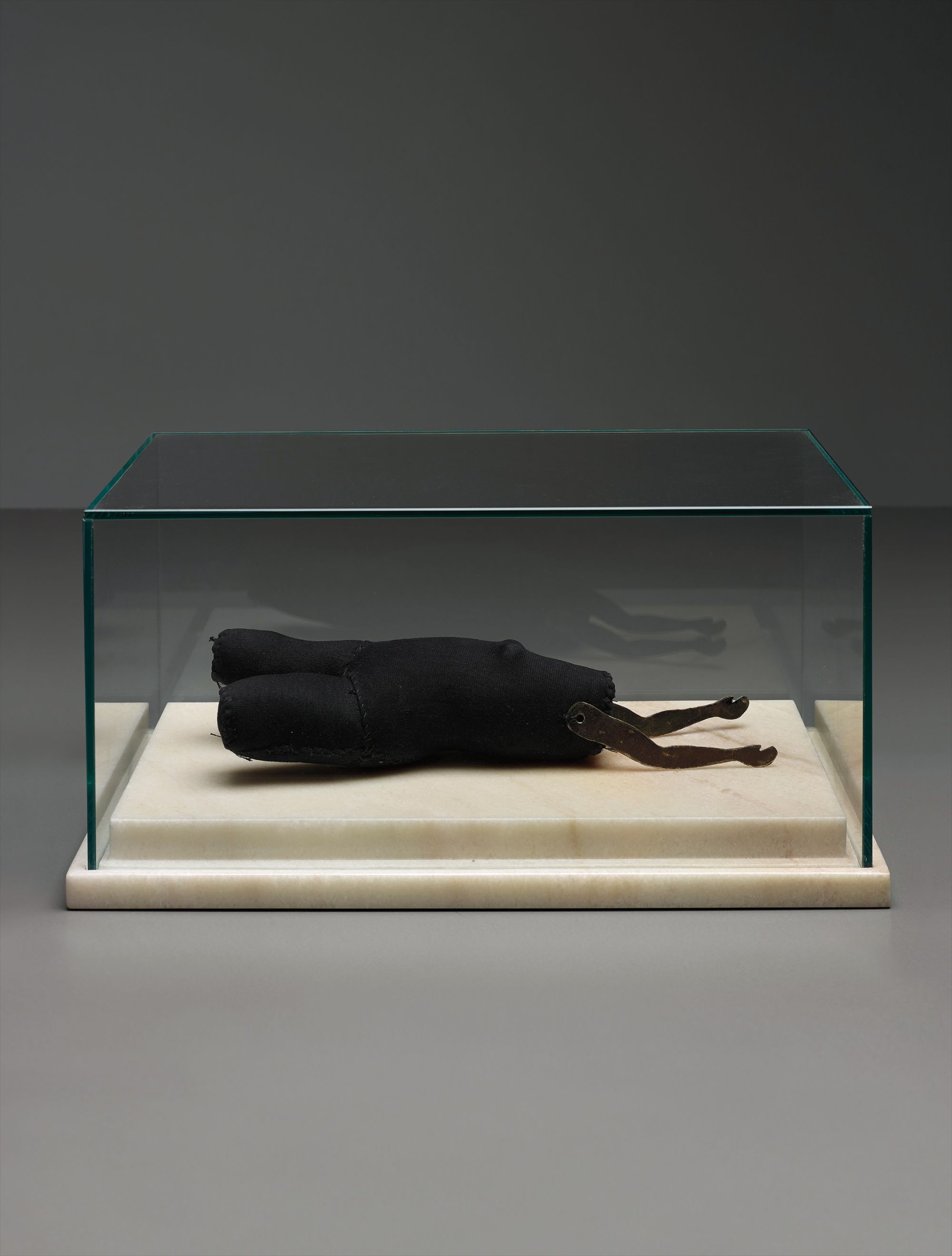

210
Louise Bourgeois
Figure
fabric, pink Portuguese marble, metal and glass
8 3/4 x 17 1/2 x 10 1/4 in. (22.2 x 44.5 x 26 cm.)
Executed in 1999, this work is unique.
Full-Cataloguing
Beginning in the mid-1990s, Louise Bourgeois executed a number of figurative sculptures composed of fabric. Typically housed in vitrines which recall the protective structure of her Cells begun a couple decades earlier, the majority of these sculptures were modeled after the female body. The present lot from 1999, a reclining female figure, exemplifies Bourgeois’s investigation of complex emotional states through the fragmentation of the body. This motif, which Bourgoeis refers to as the "part-object", appears regularly in her mature work.
In Figure, Bourgeois renders a delicately stitched body from black fabric, with outstretched arms cut from metal, recalling the artist’s memories of the Renaissance tapestries that her parents would restore in their home. The present sculpture sits upon a base made of Portuguese pink marble, further emphasizing the subject’s femininity. In its horizontal position, Bourgeois creates an object of ambivalence, one which contradicts the prescribed roles of mother, comforter and homemaker. In many of her figurative works from this period, Bourgeois emphasized the state of horizontality as communicating this ambivalence. As she explained in 1998, “horizontality is a desire to give up, to sleep and be passive, to retreat…hanging and floating are states of ambivalence and doubt” (Louise Bourgeois, quoted in Christian Meyer-Thoss, Louise Bourgeois: Designing for Free Fall, Zurich, 1992, p. 69).
In making these hanging, floating figures, Bourgeois calls attention to the perceived domestic roles of the female. Indeed, throughout the entirety of her oeuvre, Bourgeois maintains a deeply personal relationship with her work. In the fabric sculptures from the 1990s, the construction of objects with found material is a way of coming to terms with traumatic childhood memories, particularly surrounding her father’s treatment of her mother throughout her young life. The present lot seemed to be particularly cathartic for the artist, as she kept it on her desk for many years after its execution.
The human body is an important theme revisited throughout Bourgeois’s prolific oeuvre; from her earliest paintings, to her Cells begun in the 1970s, to her mature fabric works, the human body is constantly referenced and explored. In each of these periods, Bourgeois utilizes the figure to forge connections between one’s physicality and psyche. As such, Bourgeois’ figures seem not lifeless but engaged, and move beyond a conventional interpretation of femininity.
In Figure, Bourgeois renders a delicately stitched body from black fabric, with outstretched arms cut from metal, recalling the artist’s memories of the Renaissance tapestries that her parents would restore in their home. The present sculpture sits upon a base made of Portuguese pink marble, further emphasizing the subject’s femininity. In its horizontal position, Bourgeois creates an object of ambivalence, one which contradicts the prescribed roles of mother, comforter and homemaker. In many of her figurative works from this period, Bourgeois emphasized the state of horizontality as communicating this ambivalence. As she explained in 1998, “horizontality is a desire to give up, to sleep and be passive, to retreat…hanging and floating are states of ambivalence and doubt” (Louise Bourgeois, quoted in Christian Meyer-Thoss, Louise Bourgeois: Designing for Free Fall, Zurich, 1992, p. 69).
In making these hanging, floating figures, Bourgeois calls attention to the perceived domestic roles of the female. Indeed, throughout the entirety of her oeuvre, Bourgeois maintains a deeply personal relationship with her work. In the fabric sculptures from the 1990s, the construction of objects with found material is a way of coming to terms with traumatic childhood memories, particularly surrounding her father’s treatment of her mother throughout her young life. The present lot seemed to be particularly cathartic for the artist, as she kept it on her desk for many years after its execution.
The human body is an important theme revisited throughout Bourgeois’s prolific oeuvre; from her earliest paintings, to her Cells begun in the 1970s, to her mature fabric works, the human body is constantly referenced and explored. In each of these periods, Bourgeois utilizes the figure to forge connections between one’s physicality and psyche. As such, Bourgeois’ figures seem not lifeless but engaged, and move beyond a conventional interpretation of femininity.
Louise Bourgeois
French-American | B. 1911 D. 2010Known for her idiosyncratic style, Louise Bourgeois was a pioneering and iconic figure of twentieth and early twenty-first century art. Untied to an art historical movement, Bourgeois was a singular voice, both commanding and quiet.
Bourgeois was a prolific printmaker, draftsman, sculptor and painter. She employed diverse materials including metal, fabric, wood, plaster, paper and paint in a range of scale — both monumental and intimate. She used recurring themes and subjects (animals, insects, architecture, the figure, text and abstraction) as form and metaphor to explore the fragility of relationships and the human body. Her artworks are meditations of emotional states: loneliness, jealousy, pride, anger, fear, love and longing.